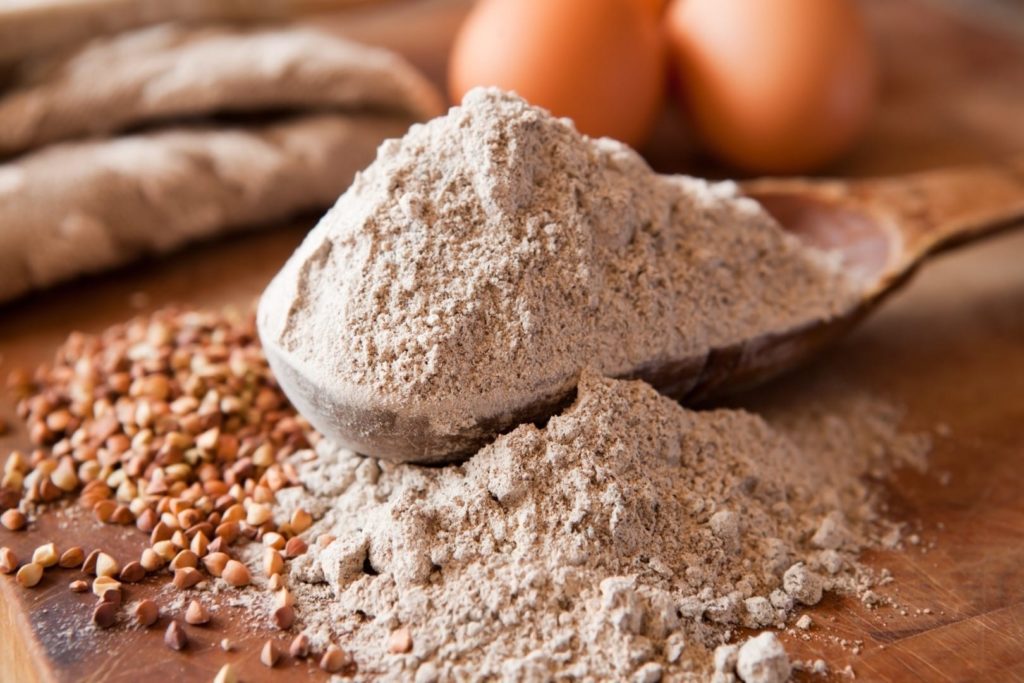If you’re anything like me, you’ve tried gluten-free flours and been disappointed by the taste and/or texture. But here’s the fab flour that I’m loving lately – It’s called SORGHUM.
Sorghum is an ancient cereal grain that originated in parts of Africa and Australia more than 5,000 years ago, and it’s been a staple for poor and rural people in tropical regions ever since. We don’t eat much of it here in the West, but the Whole Grains Council consider it to be the fifth-most important cereal crop in the world.
And there’s good reason for that! Sorghum is a 100% whole grain kernel that is ground into a fine flour for cooking and baking. White or beige in colour, sorghum flour is soft-textured and mild-tasting – not gritty, coarse or “beany,” as you find with some gluten-free flours. I find it absolutely delicious in flat bread, which is what we eat on the farm instead of bread. There’s a quick and easy recipe for my sorghum flatbreads here.
Sorghum has impressive nutrition credentials, adding a good dose of protein, iron, B vitamins and dietary fiber to recipes. It’s also surprisingly high in antioxidants like phenolic compounds and anthocyanin, which help reduce inflammation and lower free radical damage. And sorghum is GMO-free, which is important if you’re kefirising; genetically modified foods are now being linked to worsened allergies, learning disabilities, digestive issues and inflammation.
1/4 cup of sorghum flour has about:
- 120 calories
- 1 gram fat
- 25 grams carbohydrates
- 3 grams fiber
- 0 grams sugar
- 4 grams protein
- 110 milligrams phosphorus (10 percent DV)
- 1.68 milligrams iron (8 percent DV)
- 1.1 milligrams niacin (6 percent DV)
- 0.12 milligram thiamine (6 percent DV)
Why bother to eat cereal grains at all?
Achieving a gluten-free diet by simply cutting out all grains is not a good idea!
It’s really important to keep whole grains in your diet. They are health-promoting, linked to reduced risk of coronary heart disease, cancer, diabetes, obesity and other chronic diseases. And your microbiome needs them to achieve good gut health!
A whole grain contains all three parts of a grain: the bran, germ and endosperm, as opposed to a refined grain which only contains the endosperm. The nutritional riches are mostly found in the bran and the germ.
Dietary fiber in whole grains improves gut health (as a prebiotic, which feeds your good bugs), and the antioxidant and anti-inflammatory properties of most of these compounds can help prevent cancer and cardiovascular disease.
Sp, you need whole grains, but you don’t want gluten. And ideally, you don’t want high GI foods either, because they burn too quickly inside your system, creating a wave of insulin that damages your microbiome.
Sorghum to the rescue! It’s a whole grain that gluten-free AND low-GI. Sorghum actually doesn’t have an inedible hull like some other grains, so even its outer layers commonly are eaten. This means it supplies even more fiber, in addition to many other crucial nutrients, and has a lower glycemic index.
Because sorghum flour is low on the glycemic index, plus high in starch, fiber and protein, it takes longer than other similar refined-grain products to digest. This slows down the rate at which glucose (sugar) is released into the bloodstream, which is particularly helpful for anyone with blood sugar issues such as diabetes.
Sorghum also helps fill you up and prevents spikes and dips in blood sugar levels that can lead to moodiness, fatigue, cravings and overeating. One study conducted by the Department of Pharmaceutical and Biomedical Sciences at the University of Georgia suggests sorghum as a natural way to lower diabetes incidences through better control over glycation and other diabetes risk factors.
Plus, it tastes great. What’s not to love?
Here are some other reasons sorghum flour is a great choice. It is:
- High in fibre
High-fibre foods are important for digestive, hormonal and cardiovascular health. The high fibre content of sorghum flour also makes it “stick to your ribs” longer than some other refined flours or flour substitutes, so you experience less of a “crash” after eating recipes made with sorghum. - Good source of antioxidants
Sorghum is a rich source of various phytochemicals, including tannins, phenolic acids, anthocyanins, phytosterols and policosanols — which means sorghum and sorghum flour might offer similar health benefits as eating whole foods such as fruits. - Helps fight inflammation, cancer and heart disease
Eating a whole foods-based diet that is high in available phytochemicals is consistently linked to better protection from common nutrition-related diseases including cancer, cardiovascular disease and obesity. - Aids with weight loss
Sorghum contains tannins that are widely reported to reduce caloric availability and can help fight obesity, weight gain and metabolic complications.
How to use sorghum
Around the world, sorghum is used in unleavened flatbreads called jowar roti in India, as porridge eaten for breakfast or couscous served with dinner in Africa, and a flour used to thicken stews in parts of the Pacific Islands. Sorghum is also used to make both various fermented and unfermented beverages or simply consumed as a fresh vegetable in some areas of the world.
Look for 100 percent sorghum flour that hasn’t been bleached, enriched or refined. Ground sorghum flour can be used just like other gluten-free grains to make homemade baked goods like bread, muffins, pancakes and even beer! When making recipes that call for wheat flour (such as when you’re baking cakes, cookies, breads and muffins), unbleached sorghum can be added or substituted for part of the regular flour or gluten-free flour blends.
On top of providing nutrients and more fibre, an added benefit is that unlike some gluten-free flours (like rice flour or corn flour, for example), which can sometimes be crumbly, dry or gritty, sorghum flour usually has a smoother texture and a very mild taste. It’s easy to incorporate some into sweet recipes or to use a small amount to thicken stews, sauces and other savory recipes.
Using 100 percent sorghum for leavened bread isn’t usually the best idea because it won’t rise as well as lighter flours. You’ll likely get the best results if you start with recipes that use relatively small amounts of flour in general, like brownies, pancakes or flatbread, for example.
Keep in mind that without gluten to “bind” together ingredients and add to the texture of recipes, it’s a good idea to incorporate a binder like potato starch (not potato flour) to add “stretch.” You can add 1 tsp of potato starch per cup of sorghum flour – this has the additional health benefit of being a resistant starch, which feeds the good bugs inside your system, causing them to produce the immune-boosting butyrate.
Adding slightly more oil or fat (such as coconut oil or grass-fed butter) and extra eggs to recipes prepared with sorghum blends can improve the moisture content and texture. Another trick is to use apple cider vinegar, which can also improve the volume of doughs made with gluten-free blends.
Experiment with sorghum, and let us know how you’re using it!
Shann/.x















